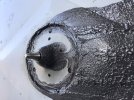remind me though ... is it not the case that normal landing procedures in the contacts FTI explicitly exclude any scan of AOA?
That sounds like a "tech-cedure" or misunderstanding. IIRC there was something in there about cross-checking it.
The landing pattern is already a big enough elephant for young students to eat and introducing AoA that early in the game is debatable (plenty of good reasons for and against).
Generally speaking the plane is 'nose at the numbers' either with a slight nose down or very slight nose up, but I certainly was never instructed to include the AOA indexer in my scan. Indeed, the contacts section on AOA landings, I think, recommends slower than usual airspeeds for the NF, TF, and LF landings, which leads me to infer that normal approach turns in the T-6 (at 120, 115, and 110) knots are flown fast rather than on speed.
Those approach turn speeds translate to on-speed during the turn if the airplane is on the heavy side, such as the "surprise" PEL on the way to high work but before burning off the typical high work gas, or a solo who has to RTB immediately after takeoff. So they work themselves out pretty well. That is if your approach turn is close to 30° bank. Similarly the final speeds for those three different flap configurations work out in the same way.
At the weights you typically beat up the pattern, you're right- those speeds are a few knots faster than on speed, and especially on your final full stop landing with ~300lbs of gas in the plane, they're about 5 knots faster.
Ask some of your IPs who flew "big wing" (Hercs, P-3, P-8) what system they used to fly approaches when the airplane is very heavy or very light. Usually it's tables of speeds in a turn and speeds on final (wings level or very small angle of bank), with a different number for each flap setting and a different table for each weight. Not surprisingly, the speeds in a turn end up being about 10 knots faster (you can crunch the numbers with the lift vector, trigonometry for a normal bank angle, and the lift equation). There's more than one way to skin a cat and "speed cards" are just another way (paper tablet you hold in your hand or a computer that spits out the pertinent numbers when you enter your current gross weight... same same).
The T-6 isn't an ideal platform to teach AoA approaches because it has a strong pitch-up tendency when you add power. It's up to the stick monkey to do his/her job and
fly the airplane and that means compensating for flight characteristics like that, but this one thing makes it a pain (the airplane is otherwise quite good for these).
Food for thought, except for fly-by-wire airplanes, most everything out there pitches up or down when you move the power (a few out there even pitch down a bit when you add power) so it's something that you just get used to. Some of them partially compensate with auto trim systems (kinda like how the TAD helps you with right rudder and power), but you still have to fly the airplane and make the machine do what it's supposed to do. When you're trying to stay awake through systems and aero, it's one thing to understand how these things make your job easier when they're working as advertised; it's quite another to apply the knowledge when those systems are broken and your job is now to recover the airplane at night and in bad weather.

